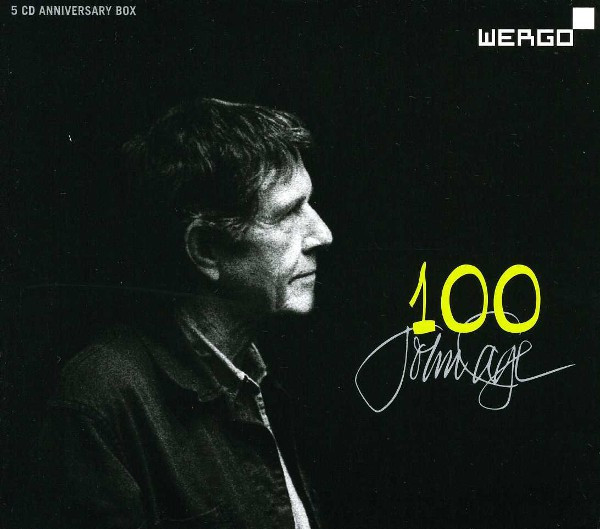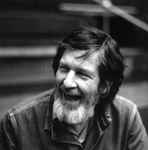MusiQ
John Cage - 100
Table of Contents
Download
Filename: john-cage-100.rar- MP3 size: 218.4 mb
- FLAC size: 2223 mb
Tracks
| Track | Duration | Preview |
|---|---|---|
| Sonata # 10 | 2:27 | |
| Concert For Piano And Orchestra | 27:44 | |
| Harmony XXIV | 2:37 | |
| Fourth Interlude | 2:38 | |
| Sonata # 4 | 2:19 | |
| Music For Two | 29:27 | |
| Sonata # 3 | 2:27 | |
| Sonata # 5 | 1:18 | |
| Sonata # 11 | 2:36 | |
| Eight Whiskus | 5:07 | |
| Sonatas And Interludes For Prepared Piano | (55:50) | |
| Second Interlude | 3:40 | |
| First Interlude | 2:53 | |
| III | 4:37 | |
| Sonata # 16 | 5:23 | |
| Sonata # 8 | 2:37 | |
| John Cage Reads The Introduction To The WDR Radio Version Of The Play, 1982 | 12:06 | |
| Harmony XIII | 1:46 | |
| Sonata # 12 | 2:42 | |
| IV | 4:23 | |
| Sonata # 2 | 2:03 | |
| II | 3:59 | |
| James Joyce, Marcel Duchamp, Erik Satie: An Alphabet | 64:35 | |
| Sonata # 1 | 2:50 | |
| Third Interlude | 2:43 | |
| Etudes Boreales For Cello Solo And Piano Solo | (19:44) | |
| Variations II | 19:52 | |
| Atlas Eclipticalis | 41:18 | |
| Sonata # 7 | 1:47 | |
| I | 5:02 | |
| 10'40.3'' For A String Player, As Part Of: 26'1.1499'' For A String Player | 10:40 | |
| Harmony XXVII | 1:45 | |
| Sonata # 6 | 1:48 | |
| Sonatas # 14 & 15 Gemini (After The Work By Richard Lippold) | 5:06 | |
| Sonata # 9 | 3:53 | |
| Etudes Boreales For A Percussionist Using A Piano | (18:01) | |
| Ryoanji | 19:51 | |
| Sonata # 13 | 3:24 | |
| Harmony XXII | 4:27 |
Images


Catalog Numbers
WER 6951 2Labels
WERGOListen online
- escuchar en línea
- kuunnella verkossa
- ouvir online
- lyssna på nätet
- écouter en ligne
- ascolta in linea
- online anhören
- online luisteren
- lytte på nettet
Formats
- 5 × CD Box Set
- Compilation
Companies
| Role | Company |
|---|---|
| Phonographic Copyright (p) | WERGO |
| Copyright (c) | WERGO |
| Glass Mastered At | Sony DADC |
Credits
| Role | Credit |
|---|---|
| Composed By | John Cage |
| Design | HJ. Kropp |
| Engineer | Gretchen Zoeckler (tracks: 1-1 to 1-19), Tom Lazarus (tracks: 2-1, 2-2) |
| Layout | Ulrike Bretz-Faust |
| Edited By | Ulrike Bretz-Faust |
| Liner Notes | Eric Salzman, Hanno Ehrler, Klaus Schöning, Peter Niklas Wilson, Petr Kotík, Richard Kostelanetz |
| Mastered By | Allan Tucker (tracks: 2-1, 2-2) |
| Photography By | Ansgar Maria Van Treeck, Astrid Karger, John Maggiotto, Peter Andersen , Roberto Sadek, Yatzek |
| Producer | Bernd Leukert (tracks: 4-1 to 4-4), Frank Kämpfer (tracks: 5-1 to 5-13), Heiner Stadler (tracks: 1-1 to 1-19, 2-1, 2-2), Rolf W. Stoll (tracks: 5-1 to 5-13) |
Notes
- CD 1: WER 60156-50, recorded in 1975
- CD 2: WER 62162, recorded in 1992
- CD 3: WER 63102, recorded in 1982 and 1990
- CD 4: WER 66362, recorded in 1998
- CD 5: WER 67182, recorded in 2009
- Sonatas And Interludes For Prepared Piano (1946-48)
- Recorded on July 26-27, 1975 at Minot Sound Studios, White Plains, New-York.
- © C. F. Peters Musikverlag Frankfurt | Leipzig | London | New York
- Concert For Piano And Orchestra (1957-58)
- Recorded on January 26, 1992 at the Willow Place Auditorium, Brooklyn, N. Y.
- Atlas Eclipticalis (1961-62)
- Recorded on March 15, 1992 at the Academy of Arts & Letters, New York City
- Mastered at Foothill Digital, New York City
- John Cage Reads The Introduction To The WDR Radio Version Of The Play, 1982
- James Joyce, Marcel Duchamp, Erik Satie: An Alphabet
- WDR Sound Art Festival 2nd Acustica International, 1990
- Performance with John Cage and friends
- Recorded at the Equitable Theatre of the Whitney Museum of American Art, New York, 29 April 1990.
- © James Joyce, Marcel Duchamp, Erik Satie: An Alphabet: John Cage Trust, New York.
- Variations II , realisation for violin and glass harmonica
- Eight Whiskus , for violin
- Music for Two , for violin and percussion
- Ryoanji (1983-85), for voice and percussion, voice part transcribed for violin by Malcolm Goldstein with permission of John Cage
- Recorded 29-30 October 1998, Studio I of Hessischer Rundfunk (HR)
- Harmony XXVII for Violoncello And Piano
- Etudes Boreales for a percussionist Using a Piano
- Harmony XXII for Violoncello And Piano
- 10'40.3", as part of 26'1.1499 for a String Player
- Harmony XXIV for Violoncello And Piano
- Etudes Boreales for Cello Solo and Piano Solo
- Harmony XIII for Violoncello And Piano
- Recorded 7-10 September 2009, Deutschland Kammermusiksaal
- ℗ + © 2012 WERGO, a division of Schott Music & Media GmbH, Mainz, Germany.
- Manufactured in Austria. Printed in Germany.
Barcodes
- Barcode (EAN): 4010228695120
- Barcode (Text): 4 010228 695120
- Label Code: LC 00846
- SPARS Code: ADD/DDD
- Rights Society: GEMA
- Other (CD 1 Catalog#): WER 6951 2
- Other (CD 2 Catalog#): WER 6952 2
- Other (CD 3 Catalog#): WER 6953 2
- Other (CD 4 Catalog#): WER 6954 2
- Other (CD 5 Catalog#): WER 6955 2
- Matrix / Runout (CD1): Sony DADC A0100217246-0101 31 A02
- Mastering SID Code (CD1, CD2): IFPI L551
- Mould SID Code (CD1): IFPI 94K5
- Matrix / Runout (CD2): Sony DADC A0100194448-0101 41 B01
- Mould SID Code (CD2, CD3, CD4): IFPI 94K7
- Matrix / Runout (CD3): Sony DADC A0100451079-0102 25 A00
- Mastering SID Code (CD3, CD5): IFPI L555
- Matrix / Runout (CD4): Sony DADC A0100278085-0101 32 A00
- Mastering SID Code (CD4): IFPI L552
- Matrix / Runout (CD5): Sony DADC A0101536987-0101 25 A00
- Mould SID Code (CD5): IFPI 94K8
About John Cage






John Cage (born September 5, 1912, Los Angeles, California, USA - died August 12, 1992, New York City, New York, USA) was an American composer, music theorist, writer, philosopher, and artist. He is best known and lauded as a pioneer of post-war avant-garde composition.
He left Pomona College early to travel in Europe (1930-31), then studied with in New York (1933-4) and in Los Angeles (1934): his first published compositions, in a rigorous atonal system of his own, date from this period. In 1937 he moved to Seattle to work as a dance accompanist, and there in 1938 he founded a percussion orchestra; his music now concerned with filling units of time with ostinatos (First Construction in Metal, 1939). He also began to use electronic devices (variable-speed turntables in Imaginary Landscape n.1, 1939) and invented the 'prepared piano', which involves placing a variety of objects between the strings of a grand piano in order to create an effective percussion orchestra under the control of two hands.
He moved to San Francisco in 1939, to Chicago in 1941 and back to New York in 1942, all the time writing music for dance companies (notably for with whom he formed a lifelong relationship), nearly always for prepared piano or percussion ensemble. There were also major concert works for the new instrument: A Book of Music (1944) and Three Dances (1945) for two prepared pianos, and the Sonatas and Interludes (1948) for one. During this period Cage became interested in Eastern philosophies, especially in Zen.
Working to remove creative choice from composition, he used coin tosses to determine events (Music of Changes for piano, 1951), wrote for 12 radios (Imaginary Landscape n.4, also 1951) and introduced other indeterminate techniques. His 4'33" (1952) has no composed sound -- only that of the environment in which it is performed; the Concert for Piano and Orchestra (1958) is an encyclopedia of indeterminate notations. Yet other works show his growing interest in the theatre of musical performance (Water Music, 1952, for pianist with a variety of non-standard equipment) and in electronics (Imaginary Landscape n.5 for randomly mixed recordings, 1952; Cartridge Music for small sounds amplified in live performance, 1960), culminating in various large-scale events staged as jamborees of haphazardness (HPSCHD for harpsichords, tapes etc, 1969). The later output is various, including indeterminate works, others fully notated within a very limited range of material, and pieces for natural resources (plants, shells).
Cage appeared widely in Europe and the USA as a lecturer and performer, having an enormous influence on younger musicians and artists.
He was married to from 1935 until their divorce in 1945.
Real Name
- John Milton Cage
- Jr.
Name Vars
- Cage
- J. Cage
- J.Cage
- JC
- John John Cage
- Johnny Cage
- Джон Кейдж
